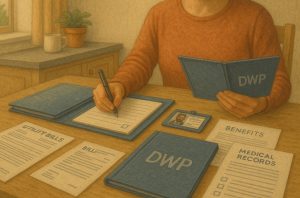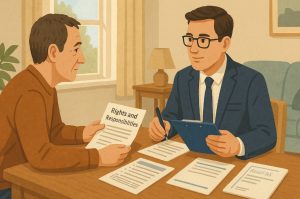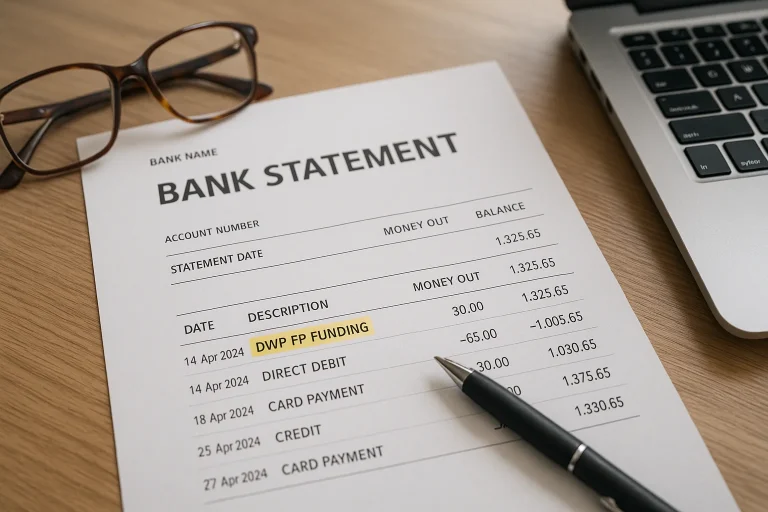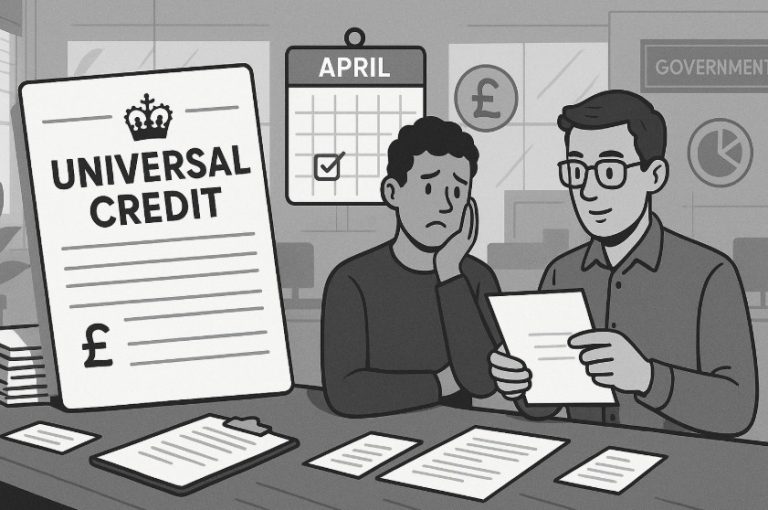Navigating the UK’s benefits system can be a complex experience, especially for individuals with unique personal circumstances.
To support those who face difficulties applying for benefits, the Department for Work and Pensions (DWP) may arrange home visits by trained officers. These visits are designed to offer guidance and help claimants access the support they’re entitled to.
This article explains why these visits occur, how to prepare, and what to expect, ensuring you’re fully informed and confident when a DWP officer visits your home.
What Is A DWP Home Visit And Who Is It For?

A DWP home visit is an in-person appointment arranged by the Department for Work and Pensions(DWP) for individuals who need support to make or manage a benefit claim.
These visits are not routine but are offered to those who experience difficulties using standard methods such as online applications or telephone-based services.
These visits are intended to:
- Help people with disabilities or complex needs navigate the benefit system
- Provide face-to-face support for first-time claimants with no external assistance
- Ensure access to benefits for those who cannot visit a Jobcentre or complete applications independently
The visit is carried out by trained DWP Visiting Officers who assist claimants with their applications, verify personal details, and gather necessary documents in a comfortable and familiar environment.
Why Might The DWP Arrange A Support Visit To Your Home?
A DWP support visit is typically arranged when a claimant is identified as needing additional help to complete or manage their benefit claim. These visits are not part of the standard application process, but they play a vital role in ensuring inclusivity and support for those facing difficulties.
Claimants With Physical Or Mental Health Conditions
Individuals with chronic illnesses, mobility issues, or mental health challenges may be unable to travel to a Jobcentre or manage an online application. The DWP arranges visits to make sure that no one is excluded from receiving benefits due to health limitations.
Examples include:
- People recovering from surgery or illness
- Individuals with anxiety or depression
- Those with neurodevelopmental conditions such as autism
First-Time Claimants With No Support Network
Some people applying for benefits may be doing so for the first time and have no one to help them understand the process. This is particularly common among young adults who have recently left care or older individuals who have become financially independent due to a change in circumstances.
DWP officers assist these individuals by:
- Explaining what documents are needed
- Helping fill out forms correctly
- Providing reassurance throughout the process
People Facing Barriers To Digital Or Telephone Communication
The shift towards digital benefit applications can be a significant barrier for some. People without internet access, a working phone, or the ability to navigate online portals can struggle to apply successfully.
Support visits help claimants who:
- Don’t own or use a computer or smartphone
- Have visual or hearing impairments
- Cannot communicate clearly over the phone due to speech or language difficulties
Individuals With Complex Life Circumstances
Some claimants face additional challenges that complicate the application process. This could include homelessness, domestic abuse, recent bereavement, or a chaotic living situation.
In such cases, a DWP officer can:
- Work sensitively within the claimant’s current environment
- Provide flexible support tailored to their needs
- Help gather missing documentation or verify circumstances
When Someone Applies To Be An Appointee?
If a friend, family member, or legal representative is applying to manage benefits on a claimant’s behalf, the DWP may visit to assess the situation and confirm that an appointeeship is necessary and appropriate. The visit helps ensure the arrangement protects the claimant’s best interests.
How Are DWP Home Visits Arranged And Who Can Refer You?

Claimants cannot book a DWP home visit themselves. Instead, the visit is typically initiated through one of the following methods:
- Contacting the DWP via the telephone number associated with the benefit being applied for
- Referral from a support agency or charitable organisation such as Citizens Advice or Age UK
- Recommendation by a healthcare worker, social worker, or carer
Once a referral is made and eligibility confirmed, the DWP will contact the claimant to schedule the appointment. Details such as the preferred date, location, and accessibility needs are taken into consideration. The visit will be confirmed by letter, and in some cases, a text message may also be sent to verify arrangements.
The following table outlines how visits may be initiated:
| Referral Method | Who Can Refer | Contact Required |
| DWP Benefit Helpline | Claimant or someone on their behalf | Yes, must call specific benefit line |
| Citizens Advice or Age UK | Organisation staff after assessing your need | Yes, with your permission |
| Healthcare or Social Worker | Professionals supporting your wellbeing | Yes, based on professional judgment |
What Should You Expect During A DWP Home Visit?
Understanding what happens during a DWP home visit can help claimants feel more prepared and comfortable with the process. These visits are designed to be supportive and informative, not intimidating or investigatory.
How The Appointment Is Scheduled?
Once eligibility for a home visit is confirmed, the DWP Visiting Team will make contact to schedule a suitable time. The claimant will be informed of:
- The proposed date and time of the visit
- The location of the meeting (usually their home)
- The officer’s name and identification details
- What documents they need to prepare
Confirmation is sent by post, and in urgent cases, a text message may also be sent if a mobile number is available.
Arrival And Identification
On the day of the visit, the DWP officer will arrive at the agreed time and location. Before entering the premises, they are required to:
- Present a DWP-issued photo ID badge
- Confirm their name and purpose of the visit
- Answer any security questions or passwords arranged in advance
Claimants are encouraged to verify the officer’s identity by checking the confirmation letter or contacting the DWP directly.
Nature Of The Visit
The focus of the visit is to help the claimant navigate the benefits system. The DWP officer may:
- Ask questions about the claimant’s living arrangements and income
- Help complete or update benefit claim forms
- Collect and review documents such as identification, tenancy agreements, and medical evidence
- Provide guidance on additional support or follow-up actions
The officer’s role is not to investigate or judge but to assist and document the necessary information for benefit processing.
What The Officer May Ask Or Discuss?
During the visit, the officer will require certain details to verify eligibility and complete the claim. Topics may include:
- The claimant’s financial situation, including savings, state pensions, or wages
- Medical conditions and how they affect daily living or employment
- Housing details such as rent payments or council tax
- Any previous benefits claimed or ongoing appeals
Claimants should answer as honestly and accurately as possible. Providing false information can affect eligibility and result in delays or complications.
Duration And Follow-Up
The length of the visit varies depending on the complexity of the case. Most visits last between 30 minutes and 1.5 hours. Before leaving, the DWP officer may:
- Summarise what was discussed and next steps
- Explain what documents, if any, are still required
- Provide contact details for any follow-up queries
In some cases, a follow-up visit may be necessary, especially if documents are missing or if the claimant needs ongoing support.
What Documents And Information Should You Prepare For The Visit?

Being prepared will help the visit run smoothly and avoid unnecessary follow-up. The DWP officer may request specific documents, so it’s best to gather these in advance.
Some of the essential documents include:
- Valid identification (passport, driving licence, birth certificate)
- Recent bank or building society statements
- Letters or documentation relating to health conditions or disabilities
- Tenancy agreement or housing documents
- Utility bills to verify your address
A well-organised set of documents will ensure the DWP officer can collect accurate information without delays. Below is a table showing which types of information are commonly required:
| Information Needed | Examples |
| Identity | Passport, driving licence, national ID card |
| Financial Status | Bank statements, payslips, pension details |
| Housing Information | Rent agreement, council tax bill |
| Health Details | Hospital letters, disability evidence, prescription list |
| Existing Benefit Support | Letters from previous or current benefits received |
Claimants may also wish to have a notepad on hand to record any important points or follow-up actions discussed during the visit.
How Can You Confirm A DWP Visit Is Genuine?
It is essential to verify the identity of the visiting officer before allowing them into your home. The DWP takes security seriously and has procedures in place to confirm the authenticity of every visit.
Key steps to verify a genuine visit:
- Check the confirmation letter or text message for the officer’s name
- Ask the officer to show their official DWP photo ID card on arrival
- If you have concerns or visual impairments, you can request a password in advance which the officer must state upon arrival
Claimants can also contact the DWP Visiting Team using the phone number provided in the letter or text to confirm the officer’s identity before the visit.
These measures protect both the claimant and the officer and ensure trust during the interaction.
Can DWP Support Visits Happen Outside Of Your Home?
While home visits are most common, the DWP understands that not all claimants can receive visitors at their residence. In these cases, the appointment may take place at an alternative location, such as:
- A hospital or care facility if the claimant is undergoing treatment
- A trusted third-party location, arranged with prior agreement
- In some rare cases, a secure public location where privacy can be maintained
The location will always be discussed and agreed upon in advance, and arrangements are made with the claimant’s comfort, safety, and accessibility in mind.
What Are Your Rights And Responsibilities During A DWP Home Visit?

Every claimant has certain rights during a DWP home visit. These are designed to maintain dignity, safety, and transparency. At the same time, there are responsibilities that help facilitate a productive and efficient meeting.
Your rights include:
- The right to be treated with respect and dignity
- The right to request rescheduling if the timing is unsuitable
- The right to have someone present during the visit for support
- The right to verify the identity of the visiting officer
Your responsibilities include:
- Providing accurate and honest information
- Preparing the requested documents ahead of the appointment
- Engaging in the process to the best of your ability
Should you feel uncomfortable or unsafe at any point, it is your right to pause the visit and contact the DWP for clarification or rescheduling.
How Long Does A DWP Support Visit Usually Take?
The duration of a DWP home visit depends on several factors. These include the number of documents the officer needs to review, the claimant’s ability to communicate clearly, and the complexity of the benefit claim.
In most cases, visits last:
- 30 to 60 minutes for straightforward cases with all documents available
- Up to 90 minutes for claims involving health issues or incomplete paperwork
If additional information is needed, the officer may schedule a follow-up or request that documents be sent to the DWP separately.
Providing a quiet and well-organised environment can help reduce the duration and ensure the visit achieves its purpose efficiently.
What Should You Do If You’re Not Comfortable With The Visit?

If at any time the claimant feels unsure about the visit, the best course of action is to contact the DWP directly. This can be done using the contact details in the confirmation letter or text message.
Claimants can:
- Request a change of location or date for the visit
- Ask for more information about the officer
- Arrange for a trusted friend or family member to be present during the visit
- Cancel and reschedule if they feel unprepared
In exceptional circumstances, a formal complaint can be made through the DWP if a claimant believes the conduct of the officer was inappropriate or if safety protocols were not followed. Claimants are encouraged to prioritise their comfort and ask for accommodations whenever needed.
Conclusion
A DWP home visit can be a valuable support tool for individuals who face challenges in claiming benefits.
Understanding what to expect, preparing the right documents, and knowing your rights can make the process smoother and less stressful. These visits are designed to assist, not intimidate, ensuring that eligible claimants receive the help they need.
By staying informed and organised, individuals can confidently navigate their benefit claims with the reassurance that support is available when it’s most needed.
FAQs about DWP Home Visits
What is the difference between a support visit and a compliance visit?
A support visit helps claimants apply for benefits, while a compliance visit investigates potential fraud or misuse. This article focuses solely on support visits.
Can a carer or family member be present during a DWP visit?
Yes, claimants can have someone present for support and to assist with communication or paperwork.
What happens if I miss a scheduled DWP visit?
You should contact the DWP Visiting Team immediately to explain and reschedule. Missing a visit without notice can delay your benefit application.
How soon after requesting help can I expect a visit?
Timelines vary based on availability and urgency, but most visits are scheduled within a few weeks of referral.
Do DWP officers carry out benefit assessments during the visit?
They may collect information that contributes to the assessment, but they do not decide eligibility on the spot.
Can I request a female or male officer for the visit?
While the DWP may try to accommodate preferences, it depends on staff availability. It’s best to raise such requests when the visit is being scheduled.
Is it mandatory to accept a DWP home visit?
If a visit is offered to help you claim benefits and you qualify for support, declining may affect your ability to complete your application if no alternative arrangements are made.
Related Articles:






